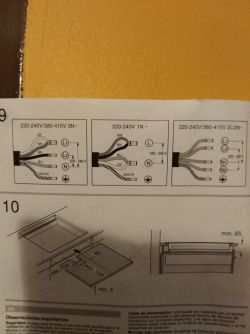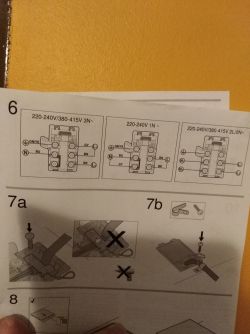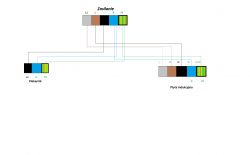FAQ
TL;DR: For a Bosch PIF651FC1E hob and a separate oven, don’t share one run: “Generally, the oven and induction should be on separate circuits.” Use the hob’s multi‑phase scheme (e.g., 2N/3N) and dedicate another circuit to the oven. [Elektroda, mawerix123, post #16902974]
Quick Facts
- Total declared loads discussed: hob 7.4 kW + oven 3.6 kW ≈ 11.0 kW combined. [Elektroda, mireczek85, post #16903437]
- Proposed supply: 3‑phase, 5×2.5 mm² cable; forum warns the scheme shown was non‑compliant. [Elektroda, CYRUS2, post #16902092]
- Forum consensus: oven and hob require separate dedicated circuits. [Elektroda, kkas12, post #16903071]
- Leaving one phase unused is acceptable; still keep the oven on its own circuit. [Elektroda, kkas12, post #16903458]
- Example protection mentioned: three‑pole B20A present in the board. [Elektroda, mireczek85, post #16903065]
Can I connect a Bosch PIF651FC1E hob and an oven to one 3‑phase 5×2.5 mm² circuit?
The forum advises against combining them. Run the hob on its intended multi‑phase connection and power the oven from a separate, dedicated circuit. This avoids overload, aligns with good practice, and simplifies fault isolation. As one expert put it: “Do not combine.” [Elektroda, kkas12, post #16903071]
Is the manual’s 3N/2N wiring diagram being misread in the thread images?
Yes. A contributor noted the referenced “3N” sketch actually mirrored L1 and showed a 2N arrangement. The gray conductor in that drawing was also flagged as unnecessary for the hob. Always follow the appliance manual’s official terminal links and jumpers. [Elektroda, mawerix123, post #16902974]
Why separate circuits for hob and oven—what’s the practical benefit?
Separate circuits prevent mutual shutdowns during faults and keep loads within design limits. Sharing one run can trip protection and disable both appliances at once. Expert quote: “You have two receivers... you should power them with separate circuits.” [Elektroda, kkas12, post #16903071]
What happens if I still combine them on one breaker?
A fault or overload on either appliance can immobilize the other, even if it’s healthy. Troubleshooting also becomes harder, and the layout may not meet accepted practice highlighted by moderators and pros in the thread. [Elektroda, kkas12, post #16903071]
Do I need to use all three phases for the hob?
Not necessarily. The hob supports multi‑phase configurations; unused phases aren’t a problem by themselves. The oven, however, should still be supplied via its own dedicated circuit, even if one phase remains unused in the board. [Elektroda, kkas12, post #16903458]
Is a 3‑pole B20A acceptable for the oven circuit if only one phase is used?
A contributor stated the three‑pole breaker could remain in place, even with one phase unused, and that alone is not a reason to swap to a two‑pole. Prioritize providing the oven with a distinct circuit path. [Elektroda, kkas12, post #16903492]
What does the gray (GY) wire shown in the sketch do for the hob?
The gray lead shown in the user’s image was called unnecessary for the induction hob. Follow the hob’s official terminal labeling and factory jumpers, not improvised bridges from user sketches. [Elektroda, mawerix123, post #16902974]
How should I balance phases if the hob is ~7.4 kW and the oven ~3.6 kW?
The OP estimated 7.4 kW + 3.6 kW. The forum’s solution is simpler: don’t co‑load a single run. Feed the hob per its rated multi‑phase scheme and feed the oven separately, avoiding forced phase‑balancing on one cable. [Elektroda, mireczek85, post #16903437]
I can’t add a new circuit at this build stage—what did pros recommend?
Pros urged doing the job correctly or not touching it, and to hire a qualified electrician rather than forcing a compromise. Quote: “Hire a professional who knows what he is doing.” [Elektroda, CYRUS2, post #16903092]
My sketch was called “non‑compliant with standards.” What did they mean?
A moderator‑level response said your schematic didn’t meet standards. That includes improper bridging and mixing loads on one run. Redo the plan: hob on its designed multi‑phase connection, oven on a separate dedicated circuit. [Elektroda, CYRUS2, post #16902092]
What’s the risk of leaving the plan as is if it seems to work on paper?
It may not bear real load. One expert wrote the connections were “correct on paper” but the installation wouldn’t carry the demanded current safely under use. That’s a failure‑mode worth avoiding. [Elektroda, CYRUS2, post #16902990]
How do I implement the forum’s recommended approach (quick 3‑step)?
- Keep the hob on its manufacturer‑specified multi‑phase terminals and jumpers.
- Run a separate, dedicated circuit for the oven from the board.
- Test each circuit independently and verify protections trip correctly. [Elektroda, kkas12, post #16903071]
Does using one shared circuit make future maintenance harder?
Yes. A shared line couples faults and trips, disabling both units and complicating diagnosis. Separate circuits isolate problems and keep one appliance running while you service the other. “In what you propose, damage to one receiver will immobilize the efficient receiver.” [Elektroda, kkas12, post #16903071]
Is 11.0 kW combined load a concern with 5×2.5 mm²?
The thread raised capacity concerns and rejected combining loads on one 5×2.5 mm² run. The safer route is separate circuits sized and protected per appliance requirements, not a single shared feed. [Elektroda, CYRUS2, post #16902990]
What if I insist on no additional circuits anyway?
Forum experts called that choice unsafe and against good practice. Quote: “There are no half‑measures... either we do it in accordance with... regulations or do not touch the topic.” [Elektroda, Krzysztof Reszka, post #16903354]








